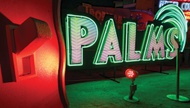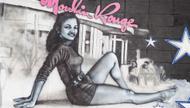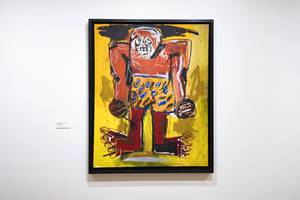Tim Burton has seen a Las Vegas you probably haven’t. That’s not a slight against your observational skills, nor a comment on how the iconic filmmaker perceives the world; it’s only to say that, statistically speaking, Burton probably first laid eyes on the city long before you did.
“I’ve been coming to Vegas since I was basically a baby,” Burton says at a press conference for the opening of his site-specific Neon Museum art show, Lost Vegas, running through February 15. “From the ‘60s and ’70s through now I’ve seen all of it change, but you’ve kept the beauty … the artistry, the color, the lights, the sights are alive. It’s something that was very powerful for me growing up. I went through the era of seeing all of the destruction; I was a witness when the Landmark [Hotel and Casino] was imploded. I have a lot of strange, base memories of Las Vegas.”
That casual admission is a bombshell: The creator of The Nightmare Before Christmas has named Las Vegas as a creative influence. Add early Vegas to Edward Gorey, German Expressionism and cheeseball 1960s sci fi, and at least two of Burton’s artistic flourishes come into sharper focus: The brothels, used car lots and nightmarish mid-mod of Beetlejuice (not to mention the otherworldly desert where rogue spirits are exiled), and his choice to set the majority of Mars Attacks in locations around Las Vegas, including the boneyard of retired casino signs that would later become the Neon Museum.
But Burton has done far more than confess his love for Las Vegas. With the full collaborative assistance of the Neon Museum and with all the know-how he has accumulated in three decades of filmmaking, Burton has made a gorgeous, multimedia valentine—not just to Las Vegas, but to the strange magic of childhood memories.
“This show is about memory,” Burton says during our one-on-one interview. It comes at the end of several exhausting days of promotional work, but Burton’s enthusiasm is undiminished. “Vegas is about weird memories. No matter whether it’s the old days or now, when people come to Vegas they probably have a strange memory about it. That’s what it’s all about. Over the years, lots of interesting, strange, beautiful “did that happen or did that not happen?’ memories. That’s sorta the vibe of Las Vegas.”
Funny he should say that, because Burton figures into my Vegas memories: I tell him that one night long ago, completely at random, I witnessed the filming of Mars Attacks from the top of the Strat’s SkyPod. My friend and I watched in soft wonder as giant balls of flame bloomed in front of Circus Circus and the Riviera. I ask if he can remember what was going through his head that night, and he flashes a huge grin:
“At that time, we were pre-digital, so we did have tanks and stuff out there! It was fun. You can’t do that now, you know what I mean? It’s always surreal when you’re shooting something like that, though the Landmark was a different case.”
The Landmark, formerly located where the Las Vegas Convention Center is now building an expansion hall, was slated for implosion during Burton’s shooting schedule. He shot the dawn collapse of the saucer-topped hotel reverently, and was surprised at the ‘deep sadness’ he felt once it was done.
“I’ll never forget the feeling,” he says. “It was like watching a dinosaur being killed.”
That sentimentality suffuses Lost Vegas. I’m reluctant to give away too much about what you’ll see—how unusual it is, to describe an art show as having plot spoilers—but it’s definitely the work of someone who remembers the Strip as a river of neon, who breathed the same showroom air as Sammy Davis Jr. and Siegfried & Roy, and who witnessed that wild sideshow exhibit at Circus Circus in which a beautiful woman morphed into a gorilla. (Bring it back, please, Phil Ruffin. And the Horse-a-Round Bar, too, if you’re listening.) Burton’s charming grotesques, his “children” (“All my children are ugly; I love them all”) are exploring the Neon Boneyard as Burton once explored Vegas: standing under the giant signs and statuary, bug-eyed at the audacity of it all.
Some of it is drawn from works you recognize. There’s a Beetlejuice sign, several life-size Martians from Mars Attacks and a scale model of the Glass Pool Inn as it appeared in Burton’s video for The Killers’ “Bones.” But most of the works comprising Lost Vegas are unique not only to this show—Burton’s first stateside museum show in a decade, by the by—but to Burton’s visual vocabulary. There’s equal parts Vegas and Burton in “Penguin Boy”; in the neon seahorses he made for the museum’s new grid wall, inspired by the Dunes pool; in the “Lost Vegas” sign itself, 40 feet tall and artificially aged; and in the mesmerizing “Robot Boy and Slot Machine.” Even if you can find these pieces on Instagram, I beg you not to. These works need to be experienced firsthand.
“[Burton] made it clear from the beginning that this is a collaboration,” Neon Museum CEO Rob McCoy says. “There were times this summer where I thought that maybe we had bit off more than we could chew. We’re still a young museum, celebrating our seventh birthday at the end of October. But both sides came together, and we made it happen.” (And the collaboration continues still: Burton and McCoy are discussing the possibility of a few pieces remaining behind as part of the Neon Museum’s permanent collection, and McCoy adds, “I wouldn’t be surprised if, sometime in the future, we have Tim back.”)
There are several ways to enjoy Lost Vegas. My inclination is to tell you to see it at night; that is, after all, the time of day when Burton does his best work. But there’s also something to be said for a daytime visit; you’re likely then to spot more of the detail Burton packed into this show, and more of the critters hiding in the Museum’s arroyos of metal and glass. And the Museum’s nighttime light show, Brilliant!, has also been Burtonized, but that’s a separate ticket.
No matter which path you choose, I promise you this: You’ll leave thinking of Las Vegas differently than you did going in. Maybe you’ll remember what Vegas looked like to you as a kid. Maybe you’ll look at the city after this and imagine aliens, monsters and robots hiding just behind its façades. Maybe you, yourself, are an alien, monster or robot and afterwards you’ll say, “Finally I am seen.”
No matter what, you’ll appreciate your place in one of the strangest places on Earth. You’ll feel proud to live in this land of dinosaurs, now and forever. And you might even begin to use Burton's version of "Whatever happens in Vegas," which he drops without ceremony: “Whatever changes in Vegas," he says, "it still remains weird.”
TIM BURTON: LOST VEGAS October 15-February 15, 2020. Monday-Wednesday, 9 a.m.-10 p.m.; Thursday-Sunday, 9 a.m.-11 p.m.; $30. Neon Museum, 702-387-6366.







